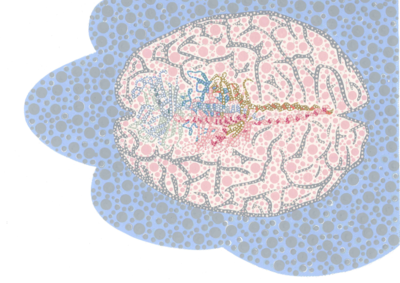Art:Turning cartwheels
From Proteopedia
Behind the Artwork and the Protein Structure
This artwork was created by Zeena N. Thompson and is entitled ‘Hope for the Three’. It depicts the Leishmania centriole protein to represent Leishmaniasis and the human brain to represent Sleeping Sickness. The cloud surrounding them highlights the similarity of Chagas disease to the others, offering hope to find one day a treatment for all three diseases: ‘every cloud has a silver lining’. The image is inspired by a molecular cartwheel which is essential for the mobility of single celled parasites called trypanosomes. Trypanosomes are the causative agents of several potentially fatal human diseases, including Leishmaniasis, Chagas disease and Sleeping Sickness.
View in 3D or go to PDB structure 4ckp [1]
Examination under a microscope reveals that many cell types have hair-like structures sprouting from their surfaces. Some of these structures, called flagella, can be longer than the cell itself. Cells usually have only one or two of these which are involved in cell motion. They function like a ship’s propeller, driving the cell through its environment. Some cells have many shorter surface ‘hairs’ called cilia which they can use to sense the environment and move things over their surface. Cells in the lining of your lungs are covered in cilia which transport mucus up the airways.
Both cilia and flagella grow from bodies called centrioles which act as a template for their assembly. The centriole itself needs to be formed on an existing structure and this has been viewed by electron microscopy to look like a cartwheel, formed of a central hub with nine spokes radiating from it. Such a structure is available in the EMDB (EMD-2329), but the detail of how it was assembled, and exactly what it was made up of, could not be determined as it could only be resolved at low resolution (38Å).
The main protein from the central hub of the complex is termed SAS-6 in Leishmania major, the organism which causes leishmaniasis. This protein has been crystallised and its structure solved to a much higher resolution (3.45Å) by a group at the LMB-MRC in Cambridge, UK. At this resolution, an order of magnitude higher than the electron microscopy studies, enables much more detail to be observed. Eighteen SAS-6 molecules spontaneously associate in the high concentrations required to form a crystal to make a ring with nine-fold symmetry, proving that the cartwheel hub can be formed of only SAS-6 molecules. There are two interfaces in the cartwheel, one formed by two intertwined helices (a coiled coil) and the other a ‘head-to-head’ interface in the globular domain.
Sas-6 Cartwheel
Not only did the group solve the structure of the SAS-6 cartwheel, but they also showed that its assembly could be disrupted by a small drug-like molecule called PK9119. Unfortunately, this molecule does not act specifically with SAS-6 from trypanosome parasites, so would not itself be useful as a treatment as humans also have a version of SAS-6. This does however represent a proof of principle that centriole assembly could be a target for developing such drugs. Drugs are available for treating trypanosome infections, but have varying degrees of adverse side effects, and there are currently no vaccines, so new drug targets are well worth exploring.
Explore the scientific publication

